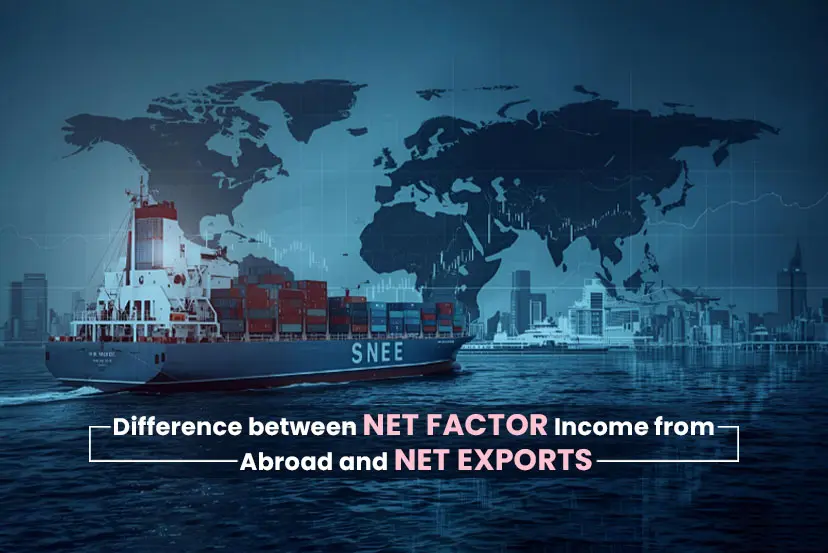It is critical to distinguish between income from trade and income from the broader category of cross-border income when evaluating a country’s performance. Net Exports only considers the net of goods and services traded across international borders. Whereas, Net Factor Income from Abroad is the difference between income earned by residents on foreign investments and income paid to foreign entities. These two components are usually treated together in terms of national income accounting, but they represent separate aspects of external economic activity. The sections below will explain NFIA and Net Exports, and why they matter in assessing a country’s overall economic position.
What is Net Factor Income from Abroad?
Net Factor Income from Abroad is the net income earned by residents of a country from foreign sources for the use of production factors. These factors include labor, capital, land, and entrepreneurship, minus the income remitted to foreign residents for similar factors used in the domestic economy. To simplify, NFIA is the net income derived from a combination of ownership and labor used beyond the country’s borders.
Net Factor Income Components
The NFIA is comprised primarily of three components:
Net Compensation of Employees: The difference between wages, salaries, and benefits earned by residents with their employment abroad and wages, salaries, and benefits paid to foreign workers in which the income is earned within the domestic economy.
Net Income From Property and Entrepreneurship: Income that includes a return from property and business income, including interest, dividends, rental income, and profits, earned by residents abroad, minus similar income paid by residents to foreign investors for their investment in the domestic economy.
Net Retained Earnings of Resident Companies Abroad: Income from profits that domestic companies retain from their operation abroad, minus profits foreign companies retain from their operations in the domestic economy.
Example of NFIA
- An Indian worker working in the United States and sending remittances to India adds positively to India’s NFIA (net factor income from abroad).
- Dividends earned from a factory owned by an Indian company in Germany. It is paid out to foreign shareholders of Indian companies, and counts towards NFIA.
The NFIA will be either positive or negative, depending on the extent to which a country’s residents earn income from foreign investments and employment or the extent to which foreigners earn income from investments or employment within that country.
What are Net Exports?
Net exports are a measurement of a country’s total goods and services exports minus the total goods and services imports over a period. This provides the balance of trade:
Net exports (NX) = Exports − Imports
- A positive value indicates a trade surplus.
- A negative value indicates a trade deficit.
Net exports are an indicator of GDP using the expenditure approach, and illustrate a country’s economic relations through the international exchange of goods and services.
Detailed Difference Between Net Exports and Net Factor Income from Abroad
It is important to understand net factor income vs net exports to better comprehend their role in macroeconomic accounting.
| Aspect | Net Factor Income from Abroad (NFIA) | Net Exports (NX) |
| Definition | Net income residents earn from foreign labor, investments, and profits minus the income foreigners earn domestically. | Value of exports minus value of imports (goods & services). |
| Key Components | Employee compensation, retained earnings, and investment earnings. | Sale and purchase of goods and services. |
| Economic Measure | Reflects cross-border income flows. | Reflects trade flows of tangible and intangible products. |
| Impact on National Income | Adjusts GDP to Gross National Product (GNP). | Directly affects Gross Domestic Product (GDP). |
| Measurement Focus | Factor payments across national borders. | International trade in goods and services. |
| Examples | Wages of citizens working abroad; dividends from foreign subsidiaries. | Export of cars; import of machinery. |
| Growth Impact | Shows income earned on foreign assets and labor. | Reflects export-driven economic growth or consumption pull. |
Why Are These Differences Important?
Distinguishing net factor income vs net exports gets us closer to understanding a country’s total income and the total of all trade. This is relevant for economic assessments or good policy development.
- GNP vs GDP: NFIA adjusts GDP to GNP, which takes into account the total income earned by residents [regardless of where it was earned], making it a more accurate indicator of residents’ income.
GNP = GDP + NFIA
- Balance of Payments: Both NFIA and net exports fall under the current account. The distinction is that NFIA refers to the flow of income, as well as net exports, representing the balance of trade.
- Policy Implications: Trade policies focus on improving net exports, either by encouraging exports or reducing imports. Generally, investment and migration policies will influence NFIA because of various remittance inflows and foreign income earned.
- Economic Health Indicator: A positive NFIA denotes strong income from international investments or labor income earned abroad, while positive net exports indicate strong competitiveness in trade.
Importance of Understanding NFIA and Net Exports for Exporters and Policymakers
Understanding net factor income from abroad and net export will be essential for both exporters and policymakers to assist those involved in external periods of economic activity. It is essential as they provide useful data to assist with financial planning, trade policy, and policy formulation for sustainable and ongoing economic growth.
For Exporters:
- Insights into net factor income from abroad provide valuable insights for an exporter into international income flows stemming from labor and investment.
- Understanding net exports provides the potential trader with a better understanding of their overall performance in trade and potential demand for export products in the market.
For Policymakers:
- Designing trade, migration, investment, and taxation policies requires accurate knowledge of income and trade flows.
- Balancing NFIA with net exports assists policymakers in supporting ongoing economic growth outcomes and stability for the currency.
Integrated Understanding for Global Economic Insight
Net Factor Income from Abroad (NFIA) and Net Exports are important for understanding a country’s economic relationship with the rest of the world. NFIA relates to income earned and paid for the factors of production internationally, while net exports relate to the actual flow of goods and services.
For exporters, these types of complicated income and trade environments have been less than ideal. However, there are many modern financial products, such as those offered by Credlix, that provide exporters with liquidity and the ability to mitigate large risks, enabling them to take full advantage of international markets.
Frequently Asked Questions
Q1: What is Net Factor Income from Abroad?
Net factor income from abroad is the net income received by resident individuals in a country from foreign sources for factors of production (like labor, capital, and entrepreneurship), minus the income sent by residents to non-residents for their use of similar factors.
Q2: Why is NFIA important in calculating Gross National Product (GNP)?
NFIA adds net income from abroad to GDP to obtain GNP, which gives a more accurate total of a country’s residents’ income, regardless of where that income is produced.
Q3: How do NFIA and Net Exports impact economic policy?
Trade policies focus on improving net exports by promoting exports or reducing imports, while investment and migration policies influence NFIA through foreign income and remittances, shaping overall economic strategy.




